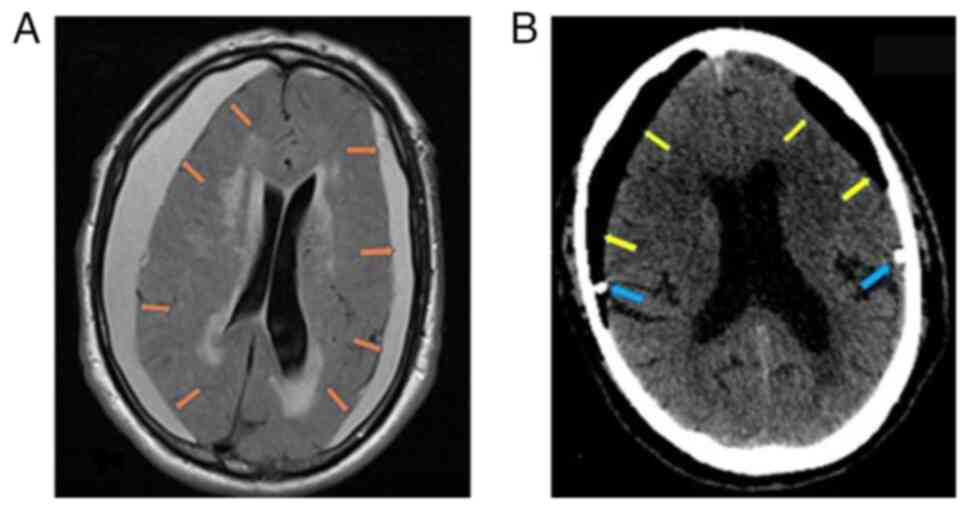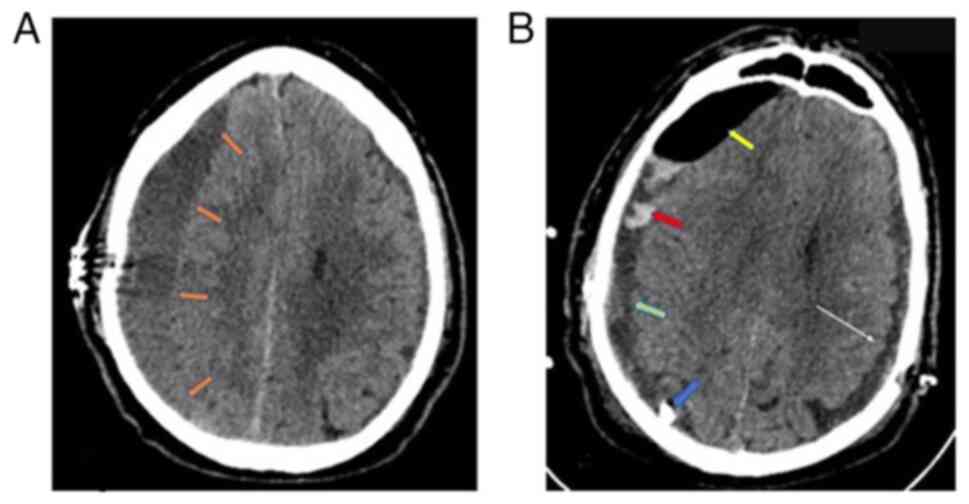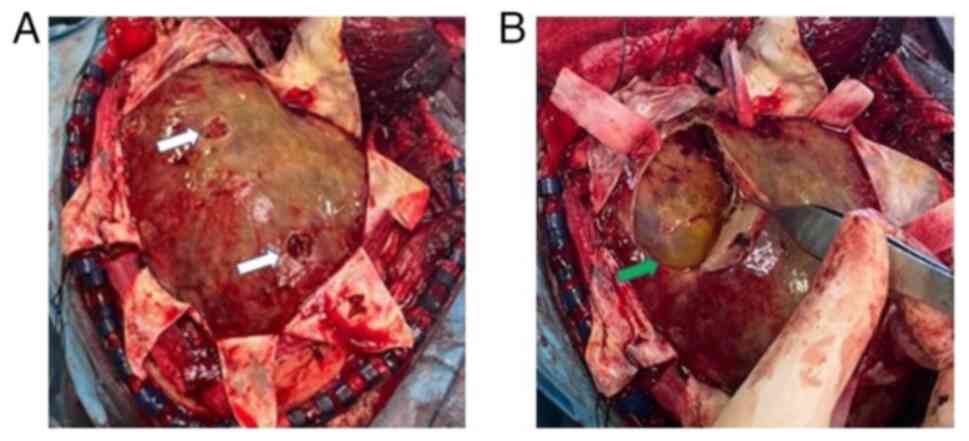|
1
|
Chang CL, Sim JL, Delgardo MW, Ruan DT and
Connolly ES Jr: Predicting chronic subdural hematoma resolution and
time to resolution following surgical evacuation. Front Neurol.
11(677)2020.PubMed/NCBI View Article : Google Scholar
|
|
2
|
Nouri A, Gondar R, Schaller K and Meling
T: Chronic subdural hematoma (cSDH): A review of the current state
of the art. Brain Spine. 1(100300)2021.PubMed/NCBI View Article : Google Scholar
|
|
3
|
Tommiska P, Lönnrot K, Raj R, Luostarinen
T and Kivisaari R: Transition of a clinical practice to use of
subdural drains after burr hole evacuation of chronic subdural
hematoma: The Helsinki experience. World Neurosurg. 129:e614–e626.
2019.PubMed/NCBI View Article : Google Scholar
|
|
4
|
Cofano F, Pesce A, Vercelli G, Mammi M,
Massara A, Minardi M, Palmieri M, D'Andrea G, Fronda C, Lanotte MM,
et al: Risk of recurrence of chronic subdural hematomas after
surgery: A multicenter observational cohort study. Front Neurol.
11(560269)2020.PubMed/NCBI View Article : Google Scholar
|
|
5
|
Hamou H, Alzaiyani M, Pjontek R, Kremer B,
Albanna W, Ridwan H, Clusmann H, Hoellig A and Veldeman M: Risk
factors of recurrence in chronic subdural hematoma and a proposed
extended classification of internal architecture as a predictor of
recurrence. Neurosurg Rev. 45:2777–2786. 2022.PubMed/NCBI View Article : Google Scholar
|
|
6
|
Shen J, Yuan L, Ge R, Wang Q, Zhou W,
Jiang XC and Shao X: Clinical and radiological factors predicting
recurrence of chronic subdural hematoma: A retrospective cohort
study. Injury. 50:1634–1640. 2019.PubMed/NCBI View Article : Google Scholar
|
|
7
|
Greuter L, Lutz K, Fandino J, Mariani L,
Guzman R and Soleman J: Drain type after burr-hole drainage of
chronic subdural hematoma in geriatric patients: A subanalysis of
the cSDH-Drain randomized controlled trial. Neurosurg Focus.
49(E6)2020.PubMed/NCBI View Article : Google Scholar
|
|
8
|
Pahatouridis D, Alexiou GA, Fotakopoulos
G, Mihos E, Zigouris A, Drosos D and Voulgaris S: Chronic subdural
haematomas: A comparative study of an enlarged single burr hole
versus double burr hole drainage. Neurosurg Rev. 36:151–154.
2013.PubMed/NCBI View Article : Google Scholar
|
|
9
|
Fountas K, Kotlia P, Panagiotopoulos V and
Fotakopoulos G: The outcome after surgical vs nonsurgical treatment
of chronic subdural hematoma with dexamethasone. Interdisciplinary
Neurosurgery. 16:70–74. 2019.
|
|
10
|
Bartek J Jr, Sjåvik K, Schaible S, Gulati
S, Solheim O, Förander P and Jakola AS: The role of
angiotensin-converting enzyme inhibitors in patients with chronic
subdural hematoma: A Scandinavian population-based multicenter
study. World Neurosurg. 113:e555–e560. 2018.PubMed/NCBI View Article : Google Scholar
|
|
11
|
Zhang JJY, Aw NMY, Tan CH, Lee KS, Chen
VHE, Wang S, Dinesh N, Foo ASC, Yang M, Goh CP, et al: Impact of
time to resumption of antithrombotic therapy on outcomes after
surgical evacuation of chronic subdural hematoma: A multicenter
cohort study. J Clin Neurosci. 89:389–396. 2021.PubMed/NCBI View Article : Google Scholar
|
|
12
|
Zhu F, Wang H, Li W, Han S, Yuan J, Zhang
C, Li Z, Fan G, Liu X, Nie M and Bie L: Factors correlated with the
postoperative recurrence of chronic subdural hematoma: An umbrella
study of systematic reviews and meta-analyses. EClinicalMedicine.
43(101234)2021.PubMed/NCBI View Article : Google Scholar
|
|
13
|
Henry J, Amoo M, Kissner M, Deane T,
Zilani G, Crockett MT and Javadpour M: Management of chronic
subdural hematoma: A systematic review and component network
meta-analysis of 455 studies with 103 645 cases. Neurosurgery.
91:842–855. 2022.PubMed/NCBI View Article : Google Scholar
|
|
14
|
Yagnik KJ, Goyal A and Van Gompel JJ:
Twist drill craniostomy vs burr hole drainage of chronic subdural
hematoma: A systematic review and meta-analysis. Acta Neurochir
(Wien). 163:3229–3241. 2021.PubMed/NCBI View Article : Google Scholar
|
|
15
|
Miah IP, Holl DC, Blaauw J, Lingsma HF,
den Hertog HM, Jacobs B, Kruyt ND, van der Naalt J, Polinder S,
Groen RJM, et al: Dexamethasone versus surgery for chronic subdural
hematoma. N Engl J Med. 388:2230–2240. 2023.PubMed/NCBI View Article : Google Scholar
|
|
16
|
Monteiro A, Housley SB, Kuo CC, Donnelly
BM, Khawar WI, Khan A, Waqas M, Cappuzzo JM, Snyder KV, Siddiqui
AH, et al: The effect of statins on the recurrence of chronic
subdural hematomas: A systematic review and meta-analysis. World
Neurosurg. 166:244–250. 2022.PubMed/NCBI View Article : Google Scholar
|
|
17
|
Yu W, Chen W, Jiang Y, Ma M, Zhang W,
Zhang X and Cheng Y: Effectiveness comparisons of drug therapy on
chronic subdural hematoma recurrence: A Bayesian network
meta-analysis and systematic review. Front Pharmacol.
13(845386)2022.PubMed/NCBI View Article : Google Scholar
|
|
18
|
Ironside N, Nguyen C, Do Q, Ugiliweneza B,
Chen CJ, Sieg EP, James RF and Ding D: Middle meningeal artery
embolization for chronic subdural hematoma: A systematic review and
meta-analysis. J Neurointerv Surg. 13:951–957. 2021.PubMed/NCBI View Article : Google Scholar
|
|
19
|
Jumah F, Osama M, Islim AI, Jumah A, Patra
DP, Kosty J, Narayan V, Nanda A, Gupta G and Dossani RH: Efficacy
and safety of middle meningeal artery embolization in the
management of refractory or chronic subdural hematomas: A
systematic review and meta-analysis. Acta Neurochir (Wien).
162:499–507. 2020.PubMed/NCBI View Article : Google Scholar
|
|
20
|
Ichimura S, Takahara K, Nakaya M, Yoshida
K and Fujii K: Neuroendoscopic Technique for recurrent chronic
subdural hematoma with small craniotomy. Turk Neurosurg.
30:701–706. 2020.PubMed/NCBI View Article : Google Scholar
|
|
21
|
Wu L, Guo X, Ou Y, Yu X, Zhu B, Yang C and
Liu W: Efficacy analysis of neuroendoscopy-assisted burr-hole
evacuation for chronic subdural hematoma: A systematic review and
meta-analysis. Neurosurg Rev. 46(98)2023.PubMed/NCBI View Article : Google Scholar
|
|
22
|
Hacıyakupoğlu E, Yılmaz DM, Kınalı B,
Arpacı T, Akbaş T and Hacıyakupoğlu S: Recurrent chronic subdural
hematoma: Report of 13 cases. Open Med (Wars). 13:520–527.
2018.PubMed/NCBI View Article : Google Scholar
|
|
23
|
Han S, Feng Y, Xu C, Li X, Zhu F, Li Z,
Zhang C and Bie L: Brain re-expansion predict the recurrence of
unilateral CSDH: A clinical grading system. Front Neurol.
13(908151)2022.PubMed/NCBI View Article : Google Scholar
|
|
24
|
Miki K, Abe H, Morishita T, Hayashi S,
Yagi K, Arima H and Inoue T: Double-crescent sign as a predictor of
chronic subdural hematoma recurrence following burr-hole surgery. J
Neurosurg. 131:1905–1911. 2019.PubMed/NCBI View Article : Google Scholar
|
|
25
|
Zhang J: Chinese Society of Neurosurgery,
Chinese Medical Association, Chinese Neurosurgical Critical Care
Specialist Council, Collaborational Group of Chinese Neurosurgical
Translational and Evidence-based Medicine. Expert consensus on drug
treatment of chronic subdural hematoma. Chin Neurosurg J.
7(47)2021.PubMed/NCBI View Article : Google Scholar
|
|
26
|
Shrestha DB, Budhathoki P, Sedhai YR, Jain
S, Karki P, Jha P, Mainali G and Ghimire P: Steroid in chronic
subdural hematoma: An updated systematic review and meta-analysis
post DEX-CSDH trial. World Neurosurg. 158:84–99. 2022.PubMed/NCBI View Article : Google Scholar
|
|
27
|
Zhao Y, Xiao Q, Tang W, Wang R and Luo M:
Efficacy and safety of glucocorticoids versus placebo as an
adjuvant treatment to surgery in chronic subdural hematoma: A
systematic review and meta-analysis of randomized controlled
clinical trials. World Neurosurg. 159:198–206. 2022.PubMed/NCBI View Article : Google Scholar
|
|
28
|
Hellwig D, Heinze S, Riegel T and Benes L:
Neuroendoscopic treatment of loculated chronic subdural hematoma.
Neurosurg Clin N Am. 11:525–534. 2000.PubMed/NCBI
|
|
29
|
Krueger EM, Gustin AJ, Gustin PJ, Jaffa Z
and Farhat H: Intraparenchymal hemorrhage after evacuation of
chronic subdural hematoma: A case series and literature review.
World Neurosurg. 155:160–170. 2021.PubMed/NCBI View Article : Google Scholar
|













